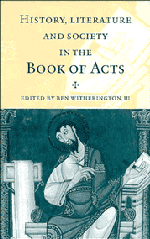Book contents
- Frontmatter
- Contents
- Preface
- PART I ISSUES OF GENRE AND HISTORICAL METHOD
- PART II HISTORICAL AND THEOLOGICAL DIFFICULTIES IN ACTS
- 6 Acts 6.1–8.4: division or diversity?
- 7 James and the Gentiles (Acts 15.13–21)
- 8 Kerygmatic summaries in the speeches of Acts
- 9 The “script” of the Scriptures in Acts: suffering as God's “plan” (βουλή) for the world for the “release of sins”
- 10 Luke's social location of Paul: cultural anthropology and the status of Paul in Acts
- PART III ISSUES OF LITERARY CRITICISM
- Index of biblical references
8 - Kerygmatic summaries in the speeches of Acts
Published online by Cambridge University Press: 02 February 2010
- Frontmatter
- Contents
- Preface
- PART I ISSUES OF GENRE AND HISTORICAL METHOD
- PART II HISTORICAL AND THEOLOGICAL DIFFICULTIES IN ACTS
- 6 Acts 6.1–8.4: division or diversity?
- 7 James and the Gentiles (Acts 15.13–21)
- 8 Kerygmatic summaries in the speeches of Acts
- 9 The “script” of the Scriptures in Acts: suffering as God's “plan” (βουλή) for the world for the “release of sins”
- 10 Luke's social location of Paul: cultural anthropology and the status of Paul in Acts
- PART III ISSUES OF LITERARY CRITICISM
- Index of biblical references
Summary
INTRODUCTION
In 1919 Martin Dibelius drew attention to a basic pattern common to the evangelistic sermons in Acts 2.14–36; 3.12–26; 10.34–43; 13–16–415 i.e. those sermons preached by Peter and Paul to audiences either of Jews or of Gentiles who already worshiped the God of Israel. The scheme common to these speeches consists of three elements: (1) the kerygma, i.e. a very short narrative of what God has done in the history of Jesus; (2) scriptural proofs demonstrating that these events fulfilled prophecy; (3) an exhortation to repentance and faith. Although Dibelius assumed that these speeches were Lucan compositions, he thought the lack of variation in Luke's composition of them shows that he must have been constrained by a preaching pattern of some antiquity.
Dibelius rather exaggerated the lack of variation in these speeches. The three elements by no means always occur in straightforward simple sequence. Often they are interwoven to some degree. Moreover, not only do the introductions to the sermons vary according to the occasion, but so do the three elements themselves. In Peter's sermon to Cornelius, for example, the theme of fulfillment of prophecy occurs (10.43a), but it is not developed by quotations of Scripture as instances of such fulfillment, as happens in the other sermons. Presumably Luke thought that this would be less appropriate in a sermon to a Gentile Godfearer. The two sermons in Jerusalem (2.14–36; 3.12–36) lack the detail about the ministry of Jesus prior to his death which can be found in the other two sermons (see 10.37–38;13.23–25).
- Type
- Chapter
- Information
- History, Literature, and Society in the Book of Acts , pp. 185 - 217Publisher: Cambridge University PressPrint publication year: 1996
- 1
- Cited by



